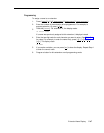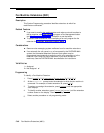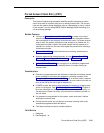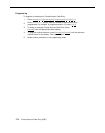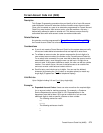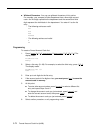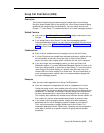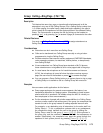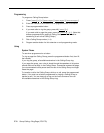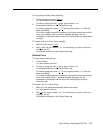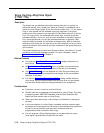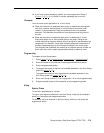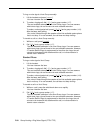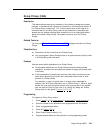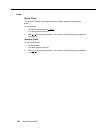
Group Calling—Ring/Page (I7G/I*7G)
Description
This feature lets users ring, page, or transfer calls simultaneously to all the
extensions in any one of four Calling Groups (G is a Calling Group number from
1–4). When paging, the caller hears a beep and begins speaking; the caller’s
voice is heard on the speakers of all idle system phones in the selected Calling
Group. The first extension to answer the call (by picking up the handset or
pressing [
Spkr ], or by pressing [ Mic ] to answer a page) is connected to the caller.
Related Features
You must use Calling Group Extensions (#502) to assign extensions to a
Calling Group.
Considerations
Extensions can be in more than one Calling Group.
Calls can be transferred to a Calling Group manually or using a button
programmed to ring the Calling Group.
Exclude extensions that connect auxiliary equipment (PARTNER Attendants,
voice messaging systems, fax machines, hotline phones, or doorphones)
from Calling Groups.
If some extensions in a Calling Group have standard or MLC-6 phones,
those extensions are not signaled at all for voice-paged calls to the group.
If a user leaves the microphone on for hands-free answer on intercom
(HFAI), the microphone is turned off when that phone receives a group
page; the user must lift the handset or press [
Mic ] to answer the page.
You can program a Group Calling button on a system phone to ring or page
a Calling Group or to transfer a call to a Calling Group with one touch.
Examples
Here are some useful applications for this feature:
■
■
■
■
■
■
■
■
Group page employees for general announcements; this feature is an
inexpensive alternative to a paging system. (Remember to install system
phones with built-in speakers—all models except the MLC-6—where you
want employees to hear announcements.)
Put the extensions of people with similar responsibilities in a Calling Group,
so when a caller needs to talk with anyone in the group, the receptionist can
transfer the call to the group instead of making separate intercom calls.
For example, a car dealership puts all extensions for the sales staff into
Calling Group 1. To let a prospective customer talk to any salesperson,
the receptionist simply transfers the call to the group by dialing the
Calling Group code for that group ([
Intercom ] [ 7 ] [ 1 ]). All the phones in
the group ring, and the customer is connected to the first salesperson to
answer. (Alternatively, the receptionist can page the group through the
speakers of their system phones by pressing [
Intercom ] [ ✳ ] [ 7 ] [ 1 ].)
Group Calling—Ring/Page (I7G/I*7G)
5-75



